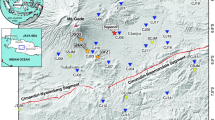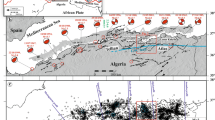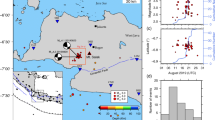Abstract
We relocate earthquakes occurring 1 week before and 1 month after the 2016 Yunlong Ms5.0 earthquake by simultaneously using P (and S) travel times and waveform cross-correlation data in the double-difference relocation algorithm. We then use the well-relocated earthquakes as template events and scan through the continuous waveforms to search for and locate weak events by using the match and locate method. A total of 4602 events are detected by using 660 templates, which is ~ 3 times the number of events listed in the Yunnan Seismic Networks catalogue. Our refined catalogue reveals three stages of seismic activity and energy release processes during the 2016 Yunlong Ms5.0 earthquake sequence. We also refine the focal depths and mechanisms of 12M ≥ 3.0 earthquakes using the broadband waveform modeling method. Both the relocated hypocenters and focal mechanisms of the 12M ≥ 3.0 earthquakes delineate fault strike and dip angles of ~ 200° and ~ 75°, respectively, indicating that the seismogenic fault could be a NNE-striking blind or subfault located between the Weixi-Qiaohou Fault and Lancangjiang Fault. Our results could contribute to better understanding of local seismic hazard evaluations in the vicinity of Yunlong area of Yunnan, China.










Similar content being viewed by others
References
Ben-Zion, Y. (2008). Collective behavior of earthquakes and faults: Continuum-discrete transitions, progressive evolutionary changes, and different dynamic regimes. Reviews of Geophysics, 46, RG4006. https://doi.org/10.1029/2008RG000260.
Ben-Zion, Y., Peng, Z., Okaya, D., Seeber, L., Armbruster, J. G., Ozer, N., et al. (2003). A shallow fault-zone structure illuminated by trapped waves in the Karadere–Duzce branch of the North Anatolian Fault, western Turkey. Geophysical Journal International, 152(3), 699–717.
Deng, Q., et al. (2007). Map of active tectonics in China. Bei**g: Seismological Press. (in Chinese).
Fang, L., Wu, J., Wang, W., Du, W., Su, J., Wang, C., et al. (2015). Aftershock observation and analysis of the 2013 Ms 7.0 Lushan earthquake. Seismological Research Letters, 86(4), 1135–1142.
Florez, M. A., & Prieto, G. A. (2017). Precise relative earthquake depth determination using array processing techniques. Journal of Geophysical Research: Solid Earth, 122, 4559–4571. https://doi.org/10.1002/2017jb014132.
Gutenberg, B., & Richter, C. F. (1944). Frequency of earthquakes in California. Bulletin of the Seismological Society of America, 34(4), 185–188.
Han, L., Zeng, X., Jiang, C., Ni, S., Zhang, H., & Long, F. (2014). Focal mechanisms of the 2013 Mw6.6 Lushan, China earthquake and high-resolution aftershock relocations. Seismological Research Letters, 85(1), 8–14.
Huang, Q., Gerstenberger, M., & Zhuang, J. (2016). Current challenges in statistical seismology. Pure and Applied Geophysics, 173(1), 1–3.
Huang, F., Qin, J., Li, Z., & Wu, C. (2007). Subarea characteristics of earthquake types in Yunnan. Acta Seismologica Sinica (in Chinese), 29(2), 142–150.
Jiang, J., Fu, H., & Chen, Q.-F. (2016). Characteristics of seismicity of the **aowan reservoir in tectonic active area from double-difference relocation analysis. Chinese Journal of Geophysics, 59(5), 605–621.
Kawamura, M., Chen, C. C., & Wu, Y. M. (2014). Seismicity change revealed by ETAS, PI, and Z-value methods: A case study of the 2013 Nantou, Taiwan earthquake. Tectonophysics, 634, 139–155.
Kumazawa, T., Ogata, Y., & Tsuruoka, H. (2017). Measuring seismicity diversity and anomalies using point process models: Case studies before and after the 2016 Kumamoto earthquakes in Kyushu, Japan. Earth, Planets and Space, 69(1), 169.
Lei, X., Ma, S., Chen, W., Pang, C., Zeng, J., & Jiang, B. (2013). A detailed view of the injection-induced seismicity in a natural gas reservoir in Zigong, southwestern Sichuan Basin, China. Journal of Geophysical Research: Solid Earth, 118(8), 4296–4311.
Lei, X., **e, C., & Fu, B. (2011). Remotely triggered seismicity in Yunnan, southwestern China, following the 2004 Mw9.3 Sumatra earthquake. Journal of Geophysical Research: Solid Earth, 116, B08303. https://doi.org/10.1029/2011jb008245.
Lei, X., Yu, G., Ma, S., Wen, X., & Wang, Q. (2008). Earthquakes induced by water injection at ~ 3 km depth within the Rongchang gas field, Chongqing, China. Journal of Geophysical Research: Solid Earth, 113, B10310. https://doi.org/10.1029/2008JB005604.
Li, T., Wu, X. P., & Wang, Y. (2010). Study on b-value distribution in Yunnan based on regional spatial scanning. Journal of Yunnan University (in Chinese), 32(6), 670–675.
Liu, Y., & Pei, S. (2017). Temporal and spatial variation of b-value before and after Wenchuan earthquake and its tectonic implication. Chinese Journal of Geophysics, 60(6), 2104–2112. https://doi.org/10.6038/cjg20170607 (in Chinese).
Luo, Y., Zhao, L., Zeng, X., & Gao, Y. (2015). Focal mechanisms of the Lushan earthquake sequence and spatial variation of the stress field. Science China Earth Sciences, 58(7), 1148–1158. https://doi.org/10.1007/s11430-014-5017-y.
Luo, J., Zhao, C., & Zhou, L. (2014). Characteristics of focal mechanisms and stress field of the Chuan-Dian rhombic block and its adjacent regions. Seismology and Geology (in Chinese), 36(2), 405–421.
Ma, S., & Atkinson, G. M. (2006). Focal depths for small to moderate earthquakes (mN ≥ 2.8) in Western Quebec, Southern Ontario, and Northern New York. Bulletin of the Seismological Society of America, 96(2), 609–623.
Mandal, P., & Horton, S. (2007). Relocation of aftershocks, focal mechanisms and stress inversion: Implications toward the seismo-tectonics of the causative fault zone of Mw7.6 2001 Bhuj earthquake (India). Tectonophysics, 429(1-2), 61–78.
Ogata, Y. (1988). Statistical models for earthquake occurrences and residual analysis for point processes. Journal of the American Statistical Association, 83(401), 9–27.
Ogata, Y. (1992). Detection of precursory relative quiescence before great earthquakes through a statistical model. Journal of Geophysical Research: Solid Earth, 97(B13), 19845–19871.
Ogata, Y., & Tsuruoka, H. (2016). Statistical monitoring of aftershock sequences: A case study of the 2015 Mw7.8 Gorkha, Nepal, earthquake. Earth, Planets and Space, 68(1), 44.
Omi, T., Ogata, Y., Hirata, Y., & Aihara, K. (2014). Estimating the ETAS model from an early aftershock sequence. Geophysical Research Letters, 41(3), 850–857. https://doi.org/10.1002/2013GL058958.
Peng, Z., & Zhao, P. (2009). Migration of early aftershocks following the 2004 Parkfield earthquake. Nature Geoscience, 2, 877–881. https://doi.org/10.1038/ngeo697.
Scholz, C. H. (1968). The frequency-magnitude relation of micro fracturing in rock and its relation to earthquakes. Bulletin of the Seismological Society of America, 58(1), 399–415.
Schorlemmer, D., Wiemer, S., & Wyss, M. (2005). Variations in earthquake-size distribution across different stress regimes. Nature, 437(7058), 539.
Utsu, T., & Ogata, Y. (1995). The centenary of the Omori formula for a decay law of aftershock activity. Journal of Physics of the Earth, 43(1), 1–33.
Vere-Jones, D., Ben-Zion, Y., & Zúñiga, R. (2005). Statistical seismology. Pure and Applied Geophysics, 162(6–7), 1023–1026.
Waldhauser, F., & Ellsworth, W. L. (2000). A double difference earthquake location algorithm method and application to the northern Hayward fault, California. Bulletin of the Seismological Society of America, 96(6), 1353–1368.
Wang, X., Bradley, K. E., Wei, S., & Wu, W. (2018). Active backstop faults in the Mentawai region of Sumatra, Indonesia, revealed by teleseismic broadband waveform modeling. Earth and Planetary Science Letters, 483, 29–38.
Wang, X., Wei, S., & Wu, W. (2017). Double-ramp on the Main Himalayan Thrust revealed by broadband waveform modeling of the 2015 Gorkha earthquake sequence. Earth and Planetary Science Letters, 473, 83–93. https://doi.org/10.1016/j.epsl.2017.05.032.
Wang, Q., Zhu, L., Su, Y., & Wang, G. (2015). Double-difference relocation of the 7 September 2012 Yiliang earthquake and its aftershock sequence. Chinese Journal of Geophysics (in Chinese), 58(9), 3205–3221. https://doi.org/10.6038/cjg20150916.
Wells, D., & Coppersmith, K. (1994). New empirical relationships among magnitude, rupture length, rupture width, rupture area, and surface displacement. Bulletin of the Seismological Society of America, 84(4), 974–1002.
Weng, H., & Yang, H. (2017). Seismogenic width controls aspect ratios of earthquake ruptures. Geophysical Research Letters, 44(6), 2725–2732. https://doi.org/10.1002/2016gl072168.
Wu, J., Ming, Y., & Wang, C. (2004). Source mechanism of small-to-moderate earthquakes and tectonic stress field in Yunnan province. Acta Seismologica Sinica (in Chinese), 26(5), 457–465.
Wu, J., Yao, D., Meng, X., Peng, Z., Su, J., & Long, F. (2017). Spatial-temporal evolutions of early aftershocks following the 2013 Mw 6.6 Lushan earthquake in Sichuan, China. Journal of Geophysical Research: Solid Earth, 122, 2873–2889. https://doi.org/10.1002/2016jb013706.
**e, Z., Zheng, Y., Yao, H., Fang, L., Zhang, Y., Liu, C., et al. (2018). Preliminary analysis on the source properties and seismogenic structure of the 2017 Ms7.0 Jiuzhaigou Earthquake. Science China Earth Sciences, 61(3), 339–352. https://doi.org/10.1007/s11430-017-9161-y.
Yang, H., Li, Z., Peng, Z., Ben-Zion, Y., & Vernon, F. (2014). Low-velocity zones along the San Jacinto Fault, Southern California, from body waves recorded in dense linear arrays. Journal of Geophysical Research: Solid Earth, 119(12), 8976–8990.
Yang, H., Zhu, L., & Chu, R. (2009). Fault-plane determination of the 18 April 2008 Mount Carmel, Illinois, earthquake by detecting and relocating aftershocks. Bulletin of the Seismological Society of America, 99(6), 3413–3420. https://doi.org/10.1785/0120090038.
Zhang, M., & Wen, L. (2015). An effective method for small event detection: Match and locate (M&L). Geophysical Journal International, 200(3), 1523–1537.
Zhang, S., & Zhou, S. (2016). Spatial and temporal variation of b-values in southwest China. Pure and Applied Geophysics, 173(1), 85–96.
Zhao, X., & Fu, H. (2014). Seismogenic structure identification of the 2013 Eryuan Ms5.5 and Ms5.0 earthquake sequence. Acta Seismologica Sinica (in Chinese), 36(4), 640–650. https://doi.org/10.3969/j.issn.0253-3782.2014.04.010.
Zhu, L., & Ben-Zion, Y. (2013). Parametrization of general seismic potency and moment tensors for source inversion of seismic waveform data. Geophysical Journal International, 194(2), 839–843.
Zhu, L., & Helmberger, D. V. (1996). Advancement in source estimation techniques using broadband regional seismograms. Bulletin of the Seismological Society of America, 86(5), 1634–1641.
Zhu, L., & Rivera, L. A. (2002). A note on the dynamic and static displacements from a point source in multilayered media. Geophysical Journal International, 148(3), 619–627.
Zhu, Y., Song, X., Liu, S., et al. (2016). Research on earthquake reference velocity structure of China. Bei**g: Seismological Press. (in Chinese).
Acknowledgements
This research was supported by the Earthquake Scientific Research of Yunnan Earthquake Agency (grants 201601, 2018ZX01, and C3-201706). Seismic waveform and catalogue data were obtained from Yunnan Seismic Networks. We are grateful to Dr. Miao Zhang for providing the M&L program package, as well as Professor ** Tools (GMT) were used for basic data processing and figure development. We thank Dr. **n Wang for help in paper writing and revision. We also thank the editor, Dr. Haijiang Zhang, and two anonymous reviewers for constructive comments and suggestions that significantly improved the quality of this paper.
Author information
Authors and Affiliations
Corresponding author
Additional information
Publisher's Note
Springer Nature remains neutral with regard to jurisdictional claims in published maps and institutional affiliations.
Electronic Supplementary Material
Below is the link to the electronic supplementary material.
Rights and permissions
About this article
Cite this article
Jiang, J., Li, J. & Fu, H. Seismicity Analysis of the 2016 Ms5.0 Yunlong Earthquake, Yunnan, China and Its Tectonic Implications. Pure Appl. Geophys. 176, 1225–1241 (2019). https://doi.org/10.1007/s00024-018-2067-7
Received:
Revised:
Accepted:
Published:
Issue Date:
DOI: https://doi.org/10.1007/s00024-018-2067-7




